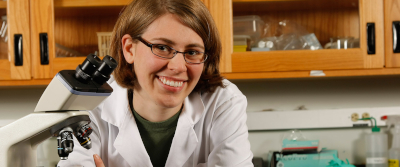Biophysics
What is Biophysics?
Biophysics is the interdisciplinary study of biology and physics.
Biophysics looks for the laws and principles in physics that describe patterns seen in biological systems. Once laws and principles are properly identified scientists can make detailed predictions that can be tested in other biological systems.
Biology studies the complexity and variety of life. It describes the life sustaining processes of organisms as they go about getting food, communicating, sensing the environment, and reproducing. Physics looks for mathematical laws that govern nature. These laws allow scientists to predict which forces drive idealized systems. Biophysicists aim to describe the complexity of life using simple physical laws. Essentially a biophysicist's job is to look for the patterns in life and analyzing them with math and physics in order to gain insight into how biological systems function.
Biophysicists are well suited for our high-tech economy. They provide innovative methods and instruments that are increasingly used to serve everyday needs, from forensic science to bioremediation.
Why Biophysics at Xavier University?
The Biophysics program provides students with a strong foundation from which to pursue a biophysics career or an advanced degree (PhD or Masters) in Biophysics, Biology, Physics, Biomechanics or Medicine doing so from the advantage of a small, liberal arts setting that is advantaged by:
- Hands-on, project based curriculum
- State of the art testing and measurement equipment, and research labs
- Small classes
- Close interaction between faculty and student
- University specific-values\community service
- Connection with the local industries
Career Options
Biophysicists work in universities, industry, medical centers, research institutes and government. Women and minorities are actively being recruited into this STEM discipline.
Biophysicists generally work in groups with people with different backgrounds, interests and abilities who collaborate to solve common problems. In industry many new positions have been created due to recent developments in molecular biophysics and molecular biology. For example, advanced biophysical research instruments are the daily workhorses of drug development in the world's pharmaceutical and biotechnology industries.
Biophysicists interested in Educational careers often become faculty or staff members at colleges, universities, medical or dental schools.
Biophysicists whose primary interest is in research often work in government, private research institutes or industry. Biophysicists can be found at the National Institutes of Health; the National Laboratories in Brookhaven, New York, Argonne, Illinois, Los Alamos, New Mexico, or Oak Ridge, Tennessee; Naval Research Laboratories; the Departments of Agriculture or Defense; the National Aeronautics and Space Administration or in private research institutes.
Biophysicists interested in biomedical engineering have given us medical imaging technologies including MRI, CAT scans, PET scans, and sonograms for diagnosing diseases.
Additionally biophysicists invented instruments for detecting, purifying, imaging, and manipulating chemicals and materials.
Course Sequence
The four-year course sequence for the biophysics major can be found on the Xavier Biophysics Fact Page.
Related Minors
- Biochemistry Minor - can be satisfied with 5 additional credit hours beyond program requirements.
- Environmental Studies Minor - can be satisfied with 8 additional credit hours beyond program requirements. Must be done in consultation with the Chair of Physics Department to substitute program electives.
- Mathematics Minor - can be satisfied with 9 additional credit hours beyond program requirements.
- Applied Mathematics Minor - can be satisfied with 9 additional credit hours beyond program requirements.
- Statistics Minor - can be satisfied with 12 additional credit hours beyond program requirements.

